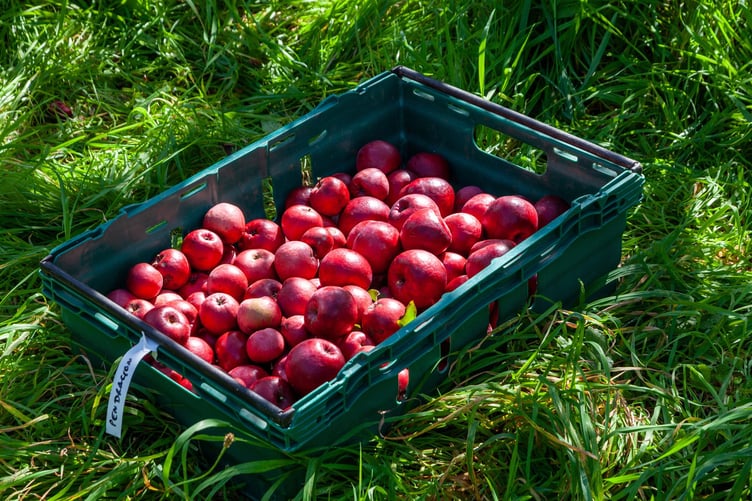WRITING a column about juicing our apple crop seems to have become an annual event, one of the ways in which I mark the turning of the seasons. I swore I wouldn’t do it this year, but I just can’t help myself, largely because I enjoy the activity so much.
The Other Half, Daughter and I have spent much of the past few weeks picking cookers and eaters from trees weighted down with the blighters. This year’s crop came earlier than usual, and was far more abundant to boot; the experts say this is down to a combination of last year’s wet conditions, a warm and dry spring and plenty of summer sun.
Last year’s eaters were in short supply; this year, our Cornish Longstems have more than made up for any previous scarcity. Our Bramleys, meanwhile, are perhaps not as sizeable as in years gone by, but are certainly more plentiful – and they hit the potting shed roof with a thud every bit as earth-shattering as their big bigger siblings.
As per usual, we headed out to Healey’s Cyder Farm to use its apple press, which is made available for a charitable donation every year between September and November. This year, we arrived with innumerable bags groaning with fruit, and as many bottles as we could find in the knowledge it would probably not be enough (and these are not for sale on site).
“Go easy on the pulping,” I said, many times, to the team (OH, Daughter and best mate) as I struggled to find a new receptacle for yet more of the amber nectar.
A four-legged friend who was not complaining was Bailey the four-month-old goat, who was gorging on any discarded pulp, and helped himself to the fresh on a couple of occasions when our eyes were off the ball.
We returned home with far more juice than our tiny fridge could cope with. The challenge is now on to drink it fast, cook with it or offload it to friends and family, in the short time before our unpasteurised ambrosia goes off.
It turns out we’re not the only ones who have struggled with an excess haul. National Trust gardens around Cornwall have also enjoyed bumper crops of apples.
The warm and sunny spring brought much-needed pollinating insects into the garden at Trelissick near Truro, and produced bountiful blossom at Cotehele in the Tamar Valley, home to the National Trust’s only Mother Orchard with 125 varieties of apple tree.
These have delivered thousands of apples around three weeks than expected. “We had to make the decision to put on an extra weekend of apple picking to ensure they didn’t go to waste, with visitors able to pick their own to enjoy at home,” said head gardener David Bouch.
“A month ago, I wasn’t overly confident - the fruit was very small, which is usually the case in very dry summers. But the apples have swollen quickly over the last couple of weeks, thanks to the rain we’ve had.”
This is in stark contrast to last year, when wet weather reduced fruit harvests and increased slug and snail activity. However, that same rain also recharged ground water levels, resulting in the soil staying moister for longer in many areas, perhaps countering this year’s record-breaking temperatures.
National Trust experts offer the following tips for caring for apples:
• Pick and handle gently to avoid bruising. Check apples have no blemishes and are dry before storing. Small quantities can be stored in a fridge salad tray. For larger quantities, ideally wrap your fruit in newspaper and keep it cool in a location such as an unheated garage. Make sure fruit isn’t touching and has good airflow. Check once a week and remove any with decay or mould, to stop it spreading.
• If storing your apples is tricky, consider making juice or stewing the fruit with sugar and freezing them for use in crumbles or pies. Alternatively put slices of apple into a low oven and dehydrate them to make apple crisps
• Looking after your apple tree will maximise chances of a good harvest. In winter, prune out diseased/dying/crossing branches and aim to create an open ‘goblet’ shape that lets the air and sunlight in. Removing straggly new growth in summer will encourage blossom.
• Choose an apple variety bred for your local conditions. Your local fruit nursery, fruit group or local National Trust property can help.
Pumpkins, meanwhile, should be picked with a bit of stalk attached and then placed in a dry, well-ventilated place (like a greenhouse or sunny windowsill) to dry out for a couple of weeks to help them ‘cure’. After this they are ready to be stored almost anywhere until Halloween or beyond.
For me, that’s it for this year’s juicing. If you have any apple recipes, sweet or savoury, please share them with me!





Comments
This article has no comments yet. Be the first to leave a comment.